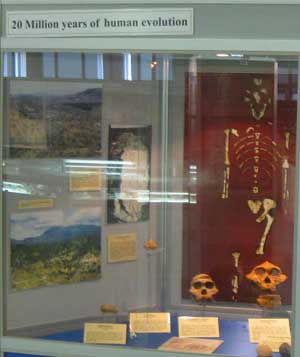
The eternal battle between apes and big cats; diorama in the beautiful Museu de Historia Natural, Maputo, Mozambique. |

Diorama depicting stone age hunter, McGregor Museum, Kimberley, South Africa. |
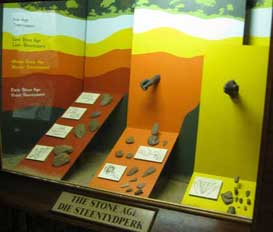
A small museum in the Stevenson-Hamilton Memorial Centre, Kruger National Park, South Africa, features a display on human evolution. |
 |
Most museum exhibitions are more interesting when they are based on the institution's own collections. When it comes to human evolution certain African museums are outstanding.
A key organisation in South Africa is the Institute for Human Evolution, headquartered in the University of Witwatersrand in central Johannesburg. The Institute administers the Origins Centre, in the same location, and the Cradle of Humankind World Heritage Site, located around Sterkfontein just outside the greater city area. In April 2010, members of the Institute and their colleagues announced the latest important fossil discovery for human evolution: Australopithicus sediba. The University Medical School also houses one of the most important fossil collections in the world.
(Left) Exhibition on human evolution near the entrance to the Institute for Human Evolution, University of Witwatersrand, Johannesburg, South Africa. This display includes a number of reproductions of fossils held by the Institute. |

Plaster casts of fossil skulls used for everyday study and demonstration at the Institute for Human Evolution. |

The Origins Centre, University of Witwatersrand, Johannesburg, South Africa. |

A spectaclar exhibition of stone tools in the Origins Centre, University of Witwatersrand. |

Tools from important locations for the appearance of modern humans, on the South African coast. |

Well-presented displays tell the story of the evolution of life and humans, and introduce the visitor to the Cradle of Humankind World Heritage Site at Sterkfontein Caves. |

Some of the fossils shown - in replica - come from the various dig sites that make up the overall 'cradle' site. The visitor sees... |

...an actual dig site. Fossils are found in breccia deposits; e.g.'Little Foot', one of the most important Australopithecus specimens ever found. |
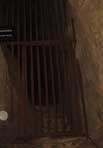
Deep underground, the breccia walls where 'Lttle Foot' was found may hold the almost complete skeleton. |

In the medical school of the University of Witwatersrand, an enthralling fossil room. |

Perhaps its greatest treasure, the three pieces of the Taung child skull sit in their box. |

The pieces assembled; their calcite sparkles under the light. |

Bernhard Zipfel, University Curator of Collections, holds the Taung child skull. |

Another key institution is the National Museum of Natural History or Transvaal Museum, in Pretoria (part of Ditsong, a relatively new institution created from a number of South African museums). Its public exhibitions include displays illustrating the evolution of life on earth, and a particularly extensive treatment of human evolution. Again, its own fossil collections are an important ingredient in the displays.
I am strongly drawn to the idea of imagining evolution in the African landscape, of dramatizing it happening to real individuals. The diorama is an underrated art form and this museum proves the point better than most. A series of small dioramas showing life and death among the australopithecines is particularly good, as are others showing the Taung child confronting the Crowned Eagle that may have killed it, and a leopard dragging away another australopithecine that it did kill. These displays have a fabulous quality in the best sense of the word, yet they are grounded in historical facts derived from solid evidence and the best science. (Note: Specimens shown below are curated at the Ditsong National Museum of Natural History [Transvaal Museum].)

Evolution in general and
the human story in
particular are laid out in
the Transvaal Museum. |

In some cases based on
fossils shown on this page... |

...the dioramas are
particularly dramatic. |
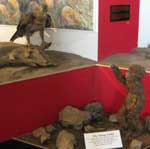 |
 |
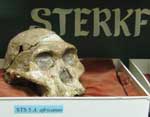
Mrs Ples, Australopithecus
africanus, in her,
or possibly his, tray
in the Broom Room,
Transvaal Museum. |

A famous pair: (left) the
leopard mandible found
with (right) a juvenile
australopithecine skullcap
at Swartkrans, near
Sterkfontein,
the fossils for the diorama
above far right. |

(Above) The skull showing
the puncture marks, and
(next right) a perfect fit. |
 |

Skull and mandible of
sabre-toothed cat species;
australopithecines would
have had to dodge these too. |
See also:
Interview with Francis Thackeray
Cradle of Humankind (Part1)
Cradle of Humankind (Part2)
Back to home page
|
The Study ackowledges its immense gratitude to Prof. Francis Thackeray, Director, Institute for Human Evolution, Dr Bernhard Zipfel, University Curator of Collections, Bernard Price Institute for Palaeontological Research, both at the University of Witwatersrand, Johannesburg, and Stephany Potze, Curator, National Museum of Natural History (Ditsong), Pretoria, for their time and great generosity in giving access to their wonderful facilities and the treasures they contain.
Text © Copyright Craig Robertson, 2010, except where otherwise attributed. Photos by Craig Robertson; the displays and objects depicted of course all belong to the institutions respectively and respectfully indicated.
Information on this page may be accessed and read for personal use. The material may not be copied or communicated to other parties without permission. |
